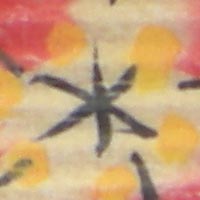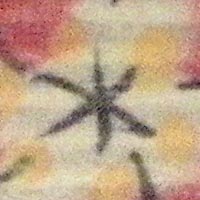Nikon Coolpix P5100 Review
Review Date: October 30th 2007
Author: Gavin Stoker
Leave a comment about this Review
|
Image Quality
All of the sample images in this Review were taken using the 12 megapixel JPEG setting, which gives an average image size of around 3-4Mb.
Noise
There are 7 ISO settings available on the Nikon Coolpix P5100 which you can select at any time if the camera is in the normal shooting mode. The biggest disappointment with the Nikon Coolpix P5100 is its handling of noise, which is visible from ISO 400 upwards, making the ISO 1600 and ISO 2000 settings practically pointless – the latter resulting in the image looking as if it was shot during a sandstorm. ISO 3200 appears similar to ISO 1600, but only because heavy noise reduction has been deployed, stripping away subtle detail in the process, and with resolution dropping to a maximum five megapixels. Here are some 100% crops which show the noise levels for each ISO setting:
ISO 64 (100% Crop) |
ISO 100 (100% Crop) |
 |
 |
ISO 200 (100% Crop) |
ISO 400 (100% Crop) |
 |
 |
ISO 800 (100% Crop) |
ISO 1600 (100% Crop) |
 |
 |
ISO 2000 (100% Crop) |
ISO 3200 (100% Crop) (5M pixels) |
 |
 |
Sharpening
Here are two 100% crops which have been Saved as Web - Quality 50 in Photoshop. The right-hand image has had some sharpening applied in Photoshop. The out-of-the camera images are just a little soft at the default sharpening setting, and benefit from some further sharpening in a program like Adobe Photoshop. You can also change the in-camera sharpening levels if you don't like the default results.
Original
(100% Crop)
|
Sharpened (100% Crop) |
 |
 |
 |
 |
Chromatic Aberrations
The Nikon Coolpix P5100 handled chromatic aberrations quite well, with purple fringing evident in areas of high contrast, especially at the edges of the frame, as shown in the examples below.
|
Example
1 (100% Crop)
|
Example
2 (100% Crop)
|
 |
 |
Macro
The Nikon Coolpix P5100 offers a Macro setting that allows you to focus on a subject that is 4cms away from the camera. The first image shows how close you can get to the subject in Macro mode (in this case a compact flash card). The second image is a 100% crop.
|
Macro Shot |
100% Crop |
 |
 |
Flash
The flash settings on the Nikon Coolpix P5100 are Auto, Red-Eye reduction, Off, On, and Slow sync. These shots of a white coloured wall were taken at a distance of 1.5m. The flash introduces a noticeable yellow cast.
|
Flash Off - Wide Angle (35mm) |
Auto Flash - Wide Angle (35mm) |
 |
 |
|
Flash Off - Telephoto (123mm) |
Auto Flash - Telephoto (123mm) |
 |
 |
And here are some portrait shots. The Auto setting caused some red-eye, which the Red-eye reduction mode almost completely removed.
|
Auto |
Auto (100% Crop) |
 |
 |
|
Red-eye reduction |
Red-eye reduction (100% Crop) |
 |
 |
Night Shot
The Nikon Coolpix P5100's maximum shutter speed is 8 seconds in the Night scene mode, which is fairly good news if you're seriously interested in night photography. The shot below was taken using a shutter speed of 1/30th second, aperture of f/2.7 at ISO 400. I've included a 100% crop of the image to show what the quality is like.
|
Night Shot |
Night Shot (100% Crop) |
 |
 |
Overall Image Quality
While some may feel that the lack of a RAW mode is a serious omission, to be picky perhaps the biggest disappointment with the Nikon Coolpix P5100 is its handling of noise, which is visible from ISO 400 upwards, making the ISO 1600 and ISO 2000 settings practically pointless – the latter resulting in the image looking as if it was shot during a sandstorm. ISO 3200 appears similar to ISO 1600, but only because heavy noise reduction has been deployed, stripping away subtle detail in the process, and with resolution dropping to a maximum five megapixels. Conversely the P5100, left to its auto default, is less than sterling in its handling of highlight detail – with 'blown' areas being largely devoid of any entirely. In the bright winter sun the camera is also particularly prone to lens flare. As expected – given our experience of previous generations of Coolpix's – the image stabilisation system isn't 100% effective, being particularly shaky when capturing images at full telephoto or attempting close ups (up to an adequate 4cm) in artificially lit interiors. But on a positive note at least it allows a greater degree of image sharpness than would be otherwise achievable. Colours have a tendency to be a little cool straight out of the camera – with the result that I selected the vivid option on occasion – but provide a more than reasonable representation of the scene before you. And, although most images are commendably sharp, I did notice softness creeping in towards the edges of the frame. Again, though there is inevitably some pixel fringing between areas of high contrast, I wouldn't say it's problematic. Altogether the Nikon Coolpix P5100 delivers a good rather than great performance when it comes to image quality, meaning it gets a 'could do better'.
|
![]() PhotographyBLOG
is a member of the DIWA
organisation. Our test results for the Nikon Coolpix P5100 have been submitted to DIWA
for comparison with test results for different samples of
the same camera model supplied by other DIWA
member sites.
PhotographyBLOG
is a member of the DIWA
organisation. Our test results for the Nikon Coolpix P5100 have been submitted to DIWA
for comparison with test results for different samples of
the same camera model supplied by other DIWA
member sites.
